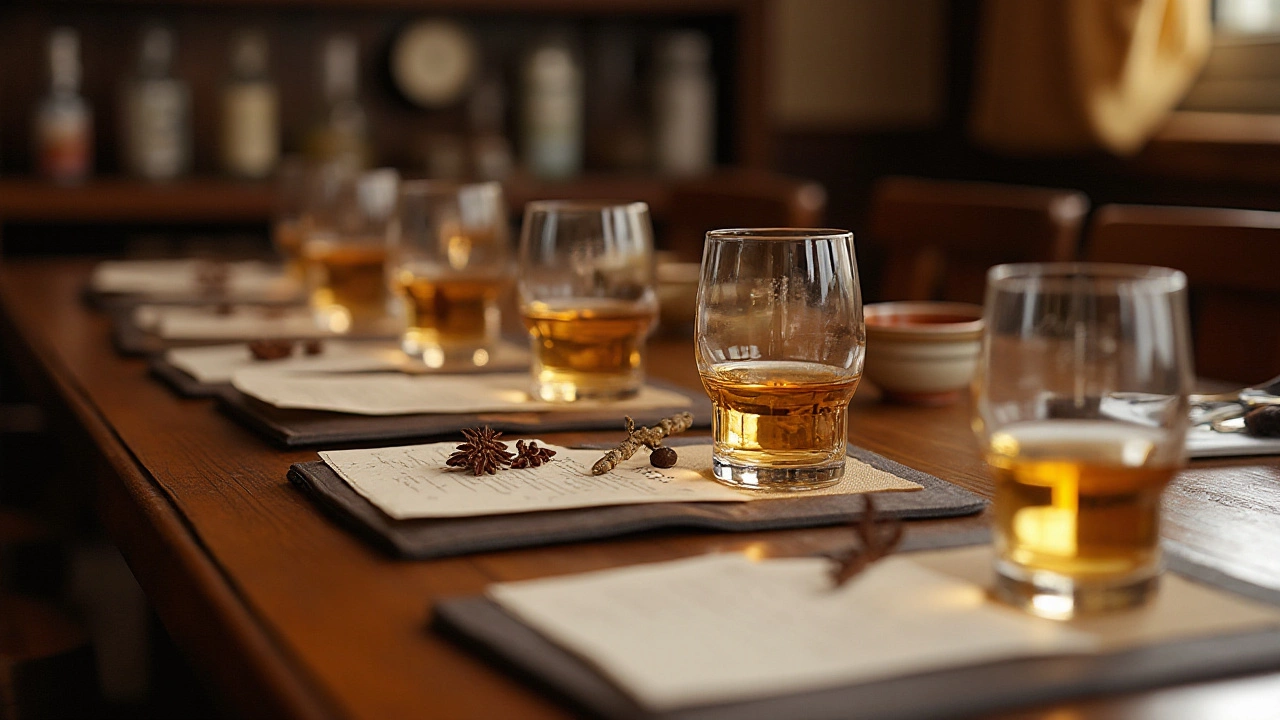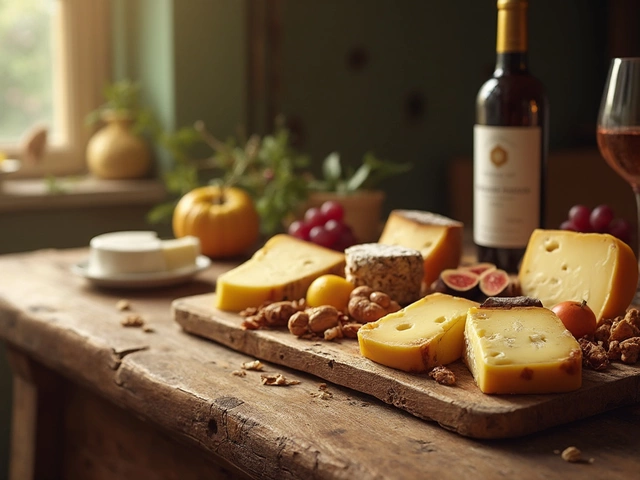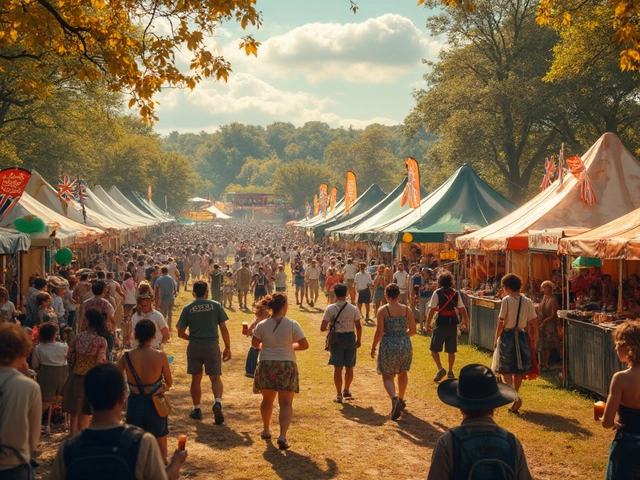Stepping into the world of whiskey can feel daunting at first, especially when you're presented with a myriad of choices and opinions. But worry not; every seasoned whiskey lover started from square one. The key is to start simple and build your understanding over time.
First, get to know the basics. Whiskey types range from Scotch to Bourbon, each with its distinct flavor profiles and histories. Choosing a good starting point might depend on personal tastes, but it's often helpful to try a few different varieties to see what appeals to you.
Glassware also plays a big role in the whiskey tasting experience, with options like Glencairn glasses enhancing the aromas. Serve your whiskey in various styles - neat, on the rocks, or with a splash of water - to explore different flavors. Learning effective tasting techniques can also make a big difference as you expand your palate and develop your tastes.
Remember, whiskey tasting is a personal journey, and there are no strict rules. Trust your senses, explore at your own pace, and enjoy the process. Welcome to a world rich in history, flavor, and tradition.
- Understanding Whiskey
- Choosing the Right Glass
- Different Ways to Serve Whiskey
- Tasting Techniques
- Developing Your Own Palate
Understanding Whiskey
Whiskey, often known as the water of life, carries a rich tapestry of history and craftsmanship that makes it one of the most cherished spirits worldwide. To truly appreciate this drink, it is essential to delve into its roots and understand what sets each variety apart. At its core, whiskey is a distilled alcoholic beverage made from fermented grain mash. The primary grains used include barley, corn, rye, and wheat, each contributing its unique characteristics to the final product. The choice of grain profoundly affects the flavor of the whiskey, with each grain offering its own distinct notes.
The production process of whiskey, while generally straightforward, can vary significantly based on both tradition and location. For instance, Scotch whisky, which is spelled without the 'e,' is predominantly made from malted barley and undergoes a different aging process than some of its counterparts. Typically, Scotch is aged for a minimum of three years in oak casks, often exuding flavors of peat and smoke. In contrast, American Bourbon, with at least 51% corn in its mash, is recognized for its sweeter notes due to higher corn content and aging in new charred oak barrels. These subtle variations contribute to the beverage's complexity and flavors.
There's often confusion surrounding the terms 'single malt' and 'blended whiskey.' A single malt is produced using malted barley and comes from a single distillery, promoting the distinct character of that location. On the other hand, blended whiskeys are precisely what they sound like – a blend of different whiskies, often resulting in smoother and more consistent flavors. Famous figures have voiced their love for whiskey, including Mark Twain who famously said, "Too much of anything is bad, but too much good whiskey is barely enough." This adoration captures the spirit's complexity that attracts both first-timers and connoisseurs alike.
Here's a brief look at some statistics that showcase the global embrace of various whiskey types.
| Type of Whiskey | Annual Global Consumption (Million Cases) |
|---|---|
| Scotch Whisky | 100 |
| American Whiskey | 50 |
| Irish Whiskey | 12 |
To truly savor whiskey, understanding these different types and what makes them unique can elevate your tasting experience. With this knowledge, new enthusiasts can confidently explore the various nuances that this timeless spirit offers. As you continue on your whiskey journey, remember that each bottle tells a story shaped by centuries of tradition, craftsmanship, and passion.
Choosing the Right Glass
When it comes to savoring your first whiskey, selecting the right glass can make a noteworthy difference in your tasting experience. While some might think any old glass will do, discerning whiskey enthusiasts know that various glassware shapes can significantly influence the flavors and aromas of their favorite drink. The most popular choice for many is the Glencairn glass, designed specifically for whisky tasting. Its tulip shape is perfect for focusing aromas towards your nose, allowing you to pick up the subtle nuances that might otherwise go undetected. This specialized glass is compact, comfortably fitting in your hand, and helps maintain the drink's ideal temperature.
Another notable contender is the snifter. Traditionally used for brandy, snifter glasses offer a wide bowl and narrow top, enhancing the aroma experience. This design allows the whiskey to breathe while directing the concentrated scents towards your nose. As you swirl the drink gently, the enticing mix of aromas begins to unfold in complex layers. It's a sensory delight that makes every sip more captivating. In contrast, those who prefer their whiskey on the rocks might opt for an old-fashioned rocks glass. Its larger bowl and thick bottom make it ideal for adding ice, and it's known for its sturdy and satisfying feel. Although the aromas may not be as pronounced as with a tulip-shaped glass, this classic choice holds a special place for whiskey lovers who enjoy their drink a bit chilled.
For those eager to explore various glassware options without a hefty price tag, considering multi-purpose tasting glasses can be a practical solution. A set of copita glasses often provides a versatile and affordable starting point. While they lack some of the flair of more specialized glassware, their small size and gentle curve offer a pleasant and efficient tasting experience. As you progress in your journey, experimenting with different glasses is not only a fun activity but also educational. Learners often find that their preference for certain glasses evolves along with their understanding of whiskey itself. Trying a new glass might bring out unexpected characteristics in your drink, opening up a world of flavor and scent you hadn't imagined before.
A whisky expert once said, "The glass is to whisky what the frame is to a painting—it shapes the experience." Choosing the right glass shows respect for the art of whisky-making and can transform the simplest drink into an unforgettable experience.
No matter where you start, remember that every choice you make—from the glass to the whiskey itself—contributes to your growing appreciation. This is about discovering what speaks to your senses and developing personal preferences that reflect your unique palate. Is there a perfect glass for whiskey? Perhaps not universally, but there is one that's perfect for your particular pleasure, and the journey to find it is part of the delightful adventure whiskey promises.

Different Ways to Serve Whiskey
Delighting in a glass of whiskey can be an art in itself, with many ways to serve this timeless spirit enhancing its flavors and aromas. For beginners, deciding just how to serve whiskey can set the stage for an amazing sensory experience, allowing one to appreciate the complex nuances of each sip.
Neat is a classic choice, which means serving whiskey straight out of the bottle with no mixers or ice. This method is favored by purists, as it offers a true taste of the whiskey in its original form. Enjoying whiskey neat allows you to savor the full bouquet of flavors unaltered, giving you direct insight into the distiller's intended experience. Some neat drinkers even prefer to warm the glass with their hands to slightly alter the temperature, releasing more aromas. For those stepping into the whiskey world, starting neat can be refreshing, albeit a bit intense.
On the other hand, on the rocks is a popular choice for those who prefer their whiskey chilled. A few ice cubes can soften the potent kick of a neat whiskey, making it more palatable for early tasters. However, the melting ice can dilute the spirit, which some might see as a downside. To tackle this, whiskey stones—small cubes made of materials like soapstone—are available as a novel solution. These stones chill your drink without watering it down, offering an optimal balance of coolness and flavor.
If you're interested in expanding your tasting journey further, consider trying whiskey with a splash of water. Just a dash of room-temperature water can unlock hidden flavors by reducing the alcohol's numbing effect. This dilution allows intricate notes to shine through and can entirely transform your tasting. As whiskey expert Jim Murray once noted, "A little water can be the difference between a good whiskey and a great one."
- Jim Murray
Beyond these basic styles, there's a whole world of cocktails to explore, each adding a unique twist to whiskey. Classic cocktails like Old Fashioned and Manhattan use simple ingredients to emphasize the whiskey's core flavors, while creativity blooms with modern concoctions. From smoky and spicy profiles to refreshing and sweet blends, whiskey cocktails cater to diverse palates and occasions. If you're hosting, offering a selection of cocktails can introduce whiskey to those who might otherwise shy away, expanding the communal enjoyment of this storied drink.
Tasting Techniques
Diving into the intricate world of whiskey tasting is not just about sipping; it's about engaging all the senses in a harmonious dance. Your first step is to clear your mind and environment of distractions to fully absorb the complexities in each glass. Begin by holding your glass against a white background to appreciate the color. The shade can tell much about the whiskey's age and type. Typically, a darker whiskey might suggest more time spent in the barrel. Swirl the whiskey gently in the glass, allowing the liquid to coat the sides and release its aromas.
Next, take in the aromas. The sense of smell is crucial in whiskey tasting, as the nose can detect a wide array of scents that the palate might miss. Bring the glass to your nose, softly inhale, and let the bouquet of the whiskey unveil itself. You might detect hints of vanilla, caramel, oak, or even smokiness. Take note of these initial scents and then swirl the whiskey once more to release additional aromas. To avoid overwhelming your nose, try inhaling with one nostril at a time or adjust the distance from your nose.
Sipping comes next, and it’s an art of its own. Take a small sip and let the whiskey roll across your tongue. This is when you begin to identify the primary flavors. Is it sweet, spicy, or do you detect a fruity note? Retain the whiskey in your mouth for a moment and experience its texture. Is it silky or robust? Then, swallow and note the finish. A good whiskey will leave an enduring impression, often evolving from its initial taste to reveal a different character at the end.
"Tasting whiskey is like experiencing a piece of art; it's subjective and personal, yet deeply rich," says whiskey expert Charles MacLean.
After tasting, it helps to jot down some notes. Documenting the flavors, scents, and overall experience can enhance your understanding and help guide future tastings. It’s a journey of exploration, so don’t be afraid to express what you sense, even if it's unique to you. Just like any skill, the more you practice, the more adept you'll become at identifying the nuances and eccentricities that make whiskey tasting a cherished experience for aficionados worldwide.
Remember, practice is key. You may also wish to compare with friends or join a tasting event to expand your knowledge further. Whiskey communities often meet to discuss different brands andflavors, sharing a communal bond united by their love for this storied drink. Even just arranging informal tastings with friends can enrich your whiskey journey. The world of whiskey is vast, and sharing it with others brings another layer of enjoyment to this timeless craft.

Developing Your Own Palate
Finding your unique preferences in the vast world of whiskey isn't something that happens overnight. It's a process that involves openness to new experiences and the willingness to savor each sip with intent. Every glass of whiskey tells its own story, brought to life by the grain it came from, the aging process it went through, and the region it hails from. Take time to explore different types, such as Scotch, Bourbon, Rye, and Irish whiskey. Each has a distinct character, from the peaty scents of an Islay Scotch to the sweeter notes of a Kentucky Bourbon. Pay attention to how these differences impact your taste sensations—do certain aromas or flavors strike a chord more than others? This will help you identify patterns in what you enjoy.
One effective way to broaden your palate is by keeping a tasting journal. By noting down what you smell, taste, and feel, you create a record that aids memory and helps track your evolving tastes. Include details like the whiskey's name, age, its distillery, and the type of cask it matured in. Describe its color, nose, palate, and finish. Over time, reviewing this journal can reveal the nuances your palate is naturally drawn to. Seek out recommendations and compare notes with friends, or dive into online communities. Learning how others perceive whiskey can deepen your understanding and appreciation of its complexities.
Another helpful practice is comparing whiskies side by side. This can illuminate subtleties you might miss when tasting them separately. Focus on the differences and similarities in sweetness, spice, and smokiness, among other characteristics. According to many whiskey experts, tasting should engage more than just your sense of taste; it requires your sense of smell and careful focus on texture as well. A simple swirl and sniff can unveil hidden layers. As Paul Hughes, a well-respected whiskey connoisseur, once said,
'Every sip of whiskey is a new adventure, a journey through layers of flavor waiting to be uncovered.'Let this idea guide you as you explore.
Don't forget to consider the setting and the mood you’re in as well. Sometimes, a cozy night by the fireplace can make a peaty Scotch feel more comforting, whereas a sunny afternoon might accentuate the light and floral aspects of an Irish whiskey. Experimenting with food pairings can also reveal new dimensions to your drink. Try pairing different whiskies with chocolate, cheese, roasted nuts, or smoked meats to see how flavors interact and enhance each other. Those new to whiskey might find it helpful to start with lighter dishes and work up to richer pairings as their palate becomes accustomed to whiskey's robust nature.
Finally, remember that developing your palate is a journey of joy and discovery, with no right or wrong way to enjoy whiskey. Celebrate your personal discoveries, indulge your senses, and relish the rich tapestry of flavors before you. The art of whiskey tasting is much about enjoyment as it is about understanding. So go ahead, pour yourself a glass, and let your palate lead the way.


